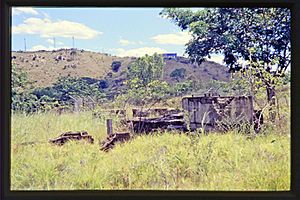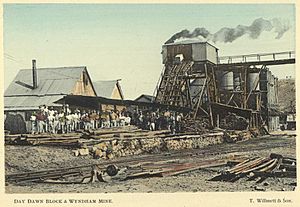Day Dawn mine remains, Charters Towers facts for kids
Quick facts for kids Day Dawn mine remains |
|
|---|---|

Day Dawn PC No.3 Shaft mine remains, 2001
|
|
| Location | Paull Street, Charters Towers, Charters Towers Region, Queensland, Australia |
| Design period | 1870s - 1890s (late 19th century) |
| Built | 1891 - 1913 |
| Official name: Day Dawn PC No.3 Shaft mine remains | |
| Type | state heritage (archaeological) |
| Designated | 29 April 2003 |
| Reference no. | 602200 |
| Significant period | 1891-1913 (fabric, historical) |
| Significant components | magazine / explosives store, mounting block/stand, shaft |
| Lua error in Module:Location_map at line 420: attempt to index field 'wikibase' (a nil value). | |
The Day Dawn mine remains are the old parts of a gold mine in Charters Towers, Queensland, Australia. This mine was very important for the area's history. It was built between 1891 and 1913. Today, it is listed on the Queensland Heritage Register because of its historical value.
Contents
Discovering Gold at Day Dawn
The Day Dawn PC No. 3 mine was part of a bigger mining area called the Day Dawn Prospecting Claim. This claim was the first gold mine in Queensland to produce gold worth £1,000,000. This amazing achievement happened in 1898.
Gold was first found in Charters Towers in late 1871. Soon, it became the richest gold mining area in North Queensland. By the early 1880s, Charters Towers was a busy and successful town. It played a big part in the growth of North Queensland.
German miners first started working the Day Dawn P.C. area in 1874. For many years, it was a "stringer," meaning it only had small veins of gold. But in 1878, miners Frederick Pfeiffer, Christian, and Levers found a rich gold vein, or "reef," about 200 feet (61 m) deep. This reef was 4 feet (1.2 m) thick and full of gold. Sometimes, it even grew to 20 feet (6.1 m) wide!
The Day Dawn PC mine was the fifth largest gold producer in Charters Towers. It processed 275,128 long tons (279,543 t) of rock and produced 379,859 ounces (10,768,800 g) of gold. After 1902, the amount of gold found started to decrease. The mine finally closed in 1913.
How the Mine Grew
In June 1887, an English company bought the mine for £470,000. They called it the Day Dawn P. C. Gold Mining Company. In their first five years (1887 to 1891), they produced 120,722 ounces (3,422,400 g) of gold. They also paid out £155,000 in profits to their investors.
Around 1891, the new English owners dug the Day Dawn PC No. 3 mine. This was a vertical shaft, meaning it went straight down into the ground. They dug it to reach the eastern part of the Day Dawn Claim, which had grown from 24 to over 55 acres (22 ha). They hoped to find the Eastward Ho reef and explore another area called the Rainbow Flat.
The original Day Dawn PC and the No. 2 mine to the west used "underlie shafts." These shafts followed the angle of the gold veins. The No. 4 shaft was dug later to the east. In 1897, the No. 3 shaft alone produced 15,000 ounces (430,000 g) of gold from 9,500 long tons (9,700 t) of rock.
From 1881 to 1913, the Day Dawn PC mine produced a total of 379,859 ounces (10,768,800 g) of gold. This came from 75,128 long tons (76,334 t) of ore. The mine also paid out £638,000 in profits. It was the fifth most valuable mine in the goldfield.
When it was working, the No. 3 shaft had three sections inside. In 1898, the shaft went down 868 feet (265 m) vertically. From there, two angled tunnels, called underlies, went further down. The total depth of the mine at that time was 1,078 feet (329 m).
What You Can See Today
Today, the mine shaft is open and clearly visible. A strong wire safety fence, put up in the 1960s, surrounds it. There is also a temporary fence on one side to prevent accidents from ground sinking, called subsidence.
About 50 metres (160 ft) to the south-west, you can see a brick building that was used to store explosives, called a magazine. To the north, there are large concrete bases where the mine's machinery once stood. You can also see the Day Dawn PC No. 4 mine to the east, which also has a temporary safety fence. The area around the shaft is mostly covered in grass.
Why This Site Is Important
The Day Dawn PC No. 3 Shaft mine remains were added to the Queensland Heritage Register on April 29, 2003. This means it is a protected historical site.
The mine remains show how important the gold mining industry was to Queensland's history. They help us understand how North Queensland developed. Along with other old mining sites, the Day Dawn PC No. 3 helps us learn about Queensland's mining past.
The remains of the No. 3 shaft, along with the machinery bases, the powder magazine, and a water tank, are some of the only things left from the Day Dawn mining era in Charters Towers. The original Day Dawn PC and No. 2 shafts no longer exist. However, you can still see the Day Dawn ridge, with Frederick Pfeiffer's house nearby. You can also see the path of the old tramway that connected these mines to the Excelsior Mill. All these things together show how much mining shaped life in Charters Towers from 1872 to 1918.
These remains and the surrounding area can still teach us a lot about mining activities from that time. They help us understand what life was like during the gold rush.


